By
Nobody was quite sure how life would change for Washingtonians when lawmakers passed the state’s landmark climate policy in 2021.
But in the nine months since the state started charging polluters, one thing has become increasingly clear: the sticker shock.
A nearly $1.5 billion price tag — so far — in fact.
That’s how much the state’s carbon-pricing auctions have raised from oil companies and other big emitters of greenhouse gasses. And the reverberations of such an economy-shifting policy can now be felt at gas pumps as those polluters pass at least some of those costs on to their customers.
On one hand, the Climate Commitment Act is a booming success, filling a state fund meant to catapult us toward a carbon-free future by subsidizing electric vehicles, electrifying homes and backing renewable energy projects. On the other hand, with hundreds of millions flowing in every quarter at higher-than-expected costs, it’s also generating an increasingly vocal opposition.
How lawmakers spend the money in the coming months could decide the fate of the fledgling policy altogether.
Detractors smear it as a hidden tax and point to higher fuel prices as an inevitable result. Right wing organizations are collecting signatures every day to earn a spot for a repeal effort on the November 2024 ballot. Should they succeed, the state’s carbon-pricing program could suffer the same fate as two carbon-tax measures voters shot down in recent years.
Lawmakers defending the policy say they’re ready for a fight and are gearing up to spend big on rebates, projects and initiatives voters care about.
But for now, Washington has over a billion dollars burning a hole in its pocket.
The program must survive, lawmakers say, because cutting greenhouse gas emissions is the most important step to avoiding the worst effects of a warming atmosphere. Already climate change is wreaking havoc around the world. While there isn’t a federal carbon-pricing program in the works, state officials say the state’s must pair with others like it to compound emission reductions and stabilize prices in carbon-allowance markets. Washington can’t solve this problem alone.
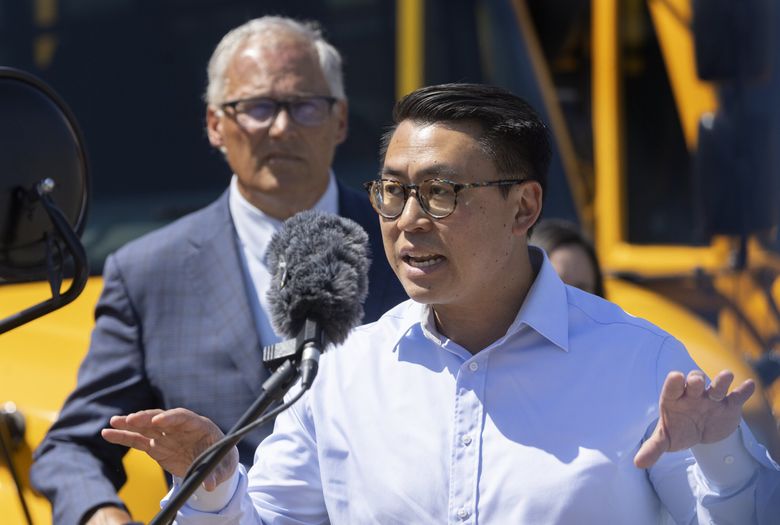
Short-term pain will pay off in the long run, said state Sen. Joe Nguyen, chair of the chamber’s Energy, Environment and Technology Committee.
“Everybody wants a six-pack, nobody wants to work out,” Nguyen said.
Still, without immediate and tangible benefits, the long-term promise of saving the planet can be a difficult sell to voters, said Aseem Prakash, a political scientist at the University of Washington.
“Climate science is very persuasive,” said Prakash, the founding director of the university’s Center for Environmental Politics. “But climate politics is a mess.”
Gov. Jay Inslee, who made climate policy a keystone of his second and final reelection campaign in 2020, stands behind the program and expressed faith that voters understand it will pay off while also cutting emissions.
“This is an investment,” Inslee said in an interview with The Times. “We make investments in things we care about in the state of Washington.”

Publicity stunt in Kent
A long time they waited, sitting in a line dozens of cars long on a short frontage road in the heart of Kent. Some even stopped in at the nearby Burger King for a bite as they passed the time.
They were waiting to save a few bucks on gas.
The line ended at Jackson’s Shell Station, just off Highway 167. The station for a few hours one Wednesday morning last month became the front lines of a fight to derail Washington’s climate policy.
Right-wing groups Future 42 and Americans for Prosperity took over operations at the station and offered a tantalizing price for a gallon of gas: the nation’s average of $3.82.
Hundreds of people showed up, some honking with excitement.
Organizers in orange vests shuffled from vehicle to vehicle, clipboards in hand, asking occupants to sign a petition that would place their repeal effort on the ballot.
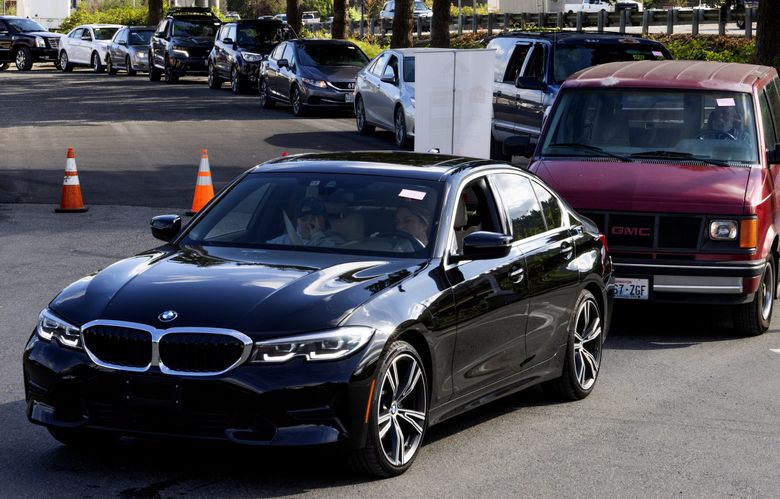
Republican megadonor Brian Heywood, one of the organizers behind the effort, stood by and watched the line of cars filter to the pumps. The repeal effort needs about 325,000 signatures by the end of the year, he said, but the team is aiming to collect about 400,000 to be safe. As of early October, Heywood said they were more than halfway there.
State Rep. Jim Walsh. R-Aberdeen, also stood by, decrying the state’s carbon-pricing program as a hidden tax and a scam. Allowances sold to polluters through the program amount to indulgences sold through the “old church,” he said.
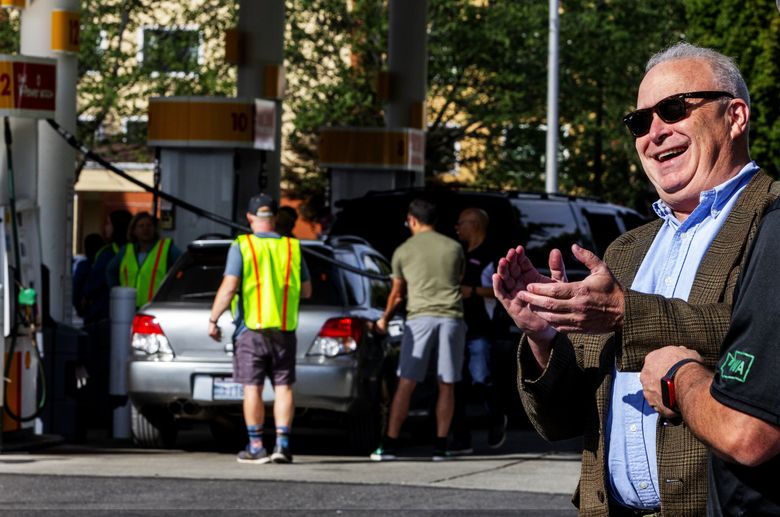
Republicans stand to gain from the widespread dissatisfaction generated by high gas prices, said Walsh, who chairs the state Republican Party. Crime and climbing costs are perhaps the biggest factors motivating people to vote.
Or in this case, to sign the petition.
Steve Murray, of Kent, signed his support on the trunk of his 2007 Lincoln Town Car while fueling up. Murray said he can’t stand Democrats, their policies or the state’s carbon-pricing program.
“You don’t even know where the money is going,” Murray said, shaking his head.
Should the repeal effort make it to the ballot, Prakash said it could succeed. Washington voters shot down a carbon tax in 2016 and a subsequent “carbon fee” in 2018.
Inslee noted that the environment — literally and politically — has changed drastically since those elections and voters have noticed.
“The world has changed since 2016. You can’t go outside and breathe in August, you have massive floods,” Inslee said, referencing some of the effects of climate change.
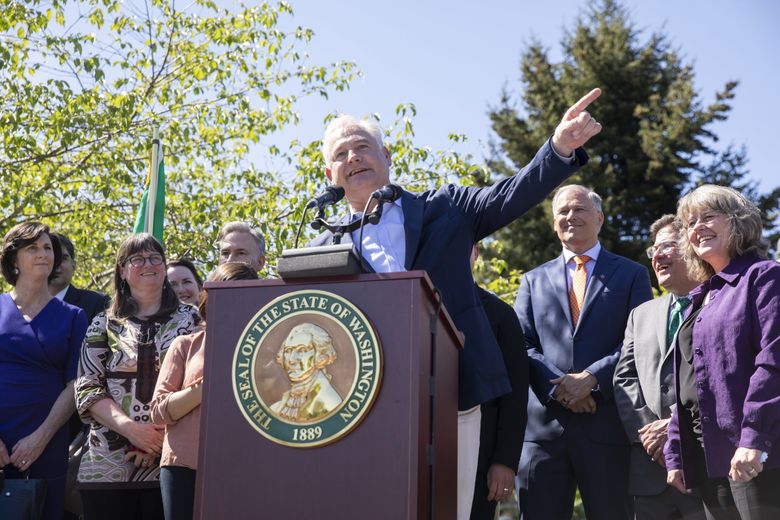
Former state Sen. Reuven Carlyle, one of the main champions of the Climate Commitment Act, which created the carbon-pricing program, warned against assuming the repeal would make the ballot. Even if it does, many businesses would likely defend the policy.
Not only did past ballot measures for carbon taxes or fees fail, but proposals also failed to pass through Washington’s Legislature. To pass the CCA, Carlyle helped bring environmental and business groups together in an effort he calls “the grand bargain.”
“This was the compromise,” Nguyen said of the carbon-pricing program. “This was the compromised version that the business community wanted, that the oil companies wanted.”
Repealing the program now would risk that a stronger one eventually replaces it, Nguyen said, so many businesses and polluters would likely stand behind the existing policy.
The program is also sure to be a top issue in the open governor’s race.
Gas prices rose this year while the price of allowances sold through the carbon-pricing program rose too.
The program requires the state’s top polluters to pay for emissions by buying allowances at quarterly auctions. Each allowance represents 1 metric ton of emissions. Over the course of seven three-year periods, state officials will reduce the number of allowances sold, thereby reducing the amount of emissions allowed in the state.
Washington’s Department of Ecology runs the auctions and set the starting allowance price at $22.20. But in the first auction in March, the price of allowances more than doubled to $48.50. Then they hit $56.01 in June and $63.03 in September, both times triggering supplemental auctions meant to act as a relief valve to steady prices.
Some gas companies began passing the cost of those allowances on to customers. At least one company listed “cap at the rack” as a line item for a more than $0.50 increase per gallon of diesel sold wholesale, referencing the state’s new program.
In the meantime oil companies are posting record profits. Representatives for British Petroleum and Phillips 66 declined to comment when asked about their increasing costs and price hikes for customers. Officials with Chevron and Marathon did not respond to requests for comment.
State officials should have expected fuel companies to shift the high cost of allowances on to consumers, said Prakash, the University of Washington political scientist.
A July 2022 letter from Ecology estimated that gas prices would rise by 5 cents per gallon and noted that state officials expect overall prices to fall over time.
“Did we expect oil companies to absorb the costs without passing it on?” Prakash said. “What world are we living in?”
Inslee, who previously anticipated the increase of gas prices would amount to “pennies,” acknowledged rates rose higher than expected but added that his administration’s analysis was done in good faith.
“We don’t predict Wall Street perfectly,” he said.
State officials push back on the degree to which high gas prices stem from the carbon-pricing program. International politics — like Russia’s ongoing invasion of Ukraine — infrastructure repairs and even the time of year can influence pricing, said Andrew Wineke, a spokesperson for Ecology.
In addition, gas prices rose even higher last summer before the carbon-pricing market launched.
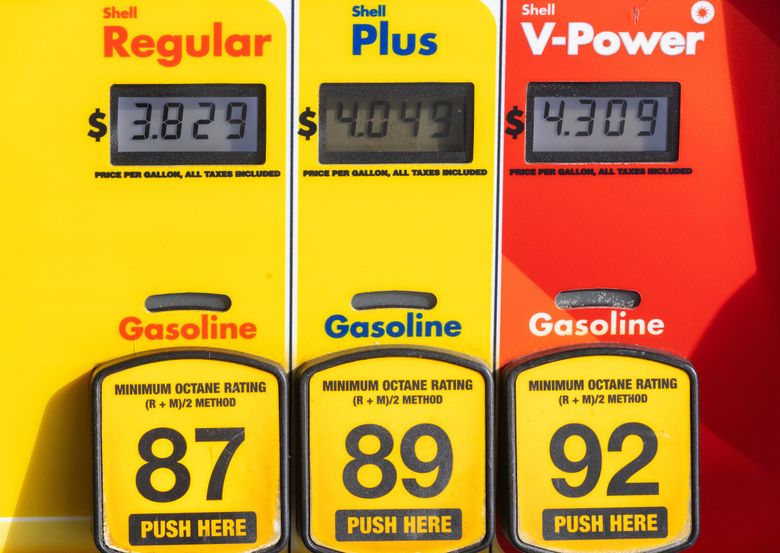
Likely, about 25 to 35 cents of Washington’s high gas prices — currently second-highest in the country — stem from oil companies passing their costs on to consumers, Wineke said.
Nguyen said he expects the price of allowances to fall in the coming auctions, which should alleviate pressure at the pump.
While Nguyen and state representatives Joe Fitzgibbon and Beth Doglio go so far as to say fuel companies might even be “price gouging,” they acknowledge there’s little that can be done. Perhaps in the coming legislative session, they say, lawmakers can force more pricing transparency from the companies.
In addition, spending money raised by the auctions — the Legislature already budgeted for some $1.7 billion in projects — can help sway public opinion in favor of the program, Fitzgibbon said.
“Knowing that we’re experiencing the growing pains of this program, what are the ways we can show results quickly?” asked Fitzgibbon, the House majority leader.
Some voters are keeping an open mind.
Lisa Bosques waited in line for cheaper gas in Kent last month. She questioned whether state officials launched the carbon-pricing program without fully understanding the implications. But she also said she might be willing to accept higher gas prices if she felt assured the policy would be effective in reducing emissions and if she had a clear understanding of where the money raised would go.
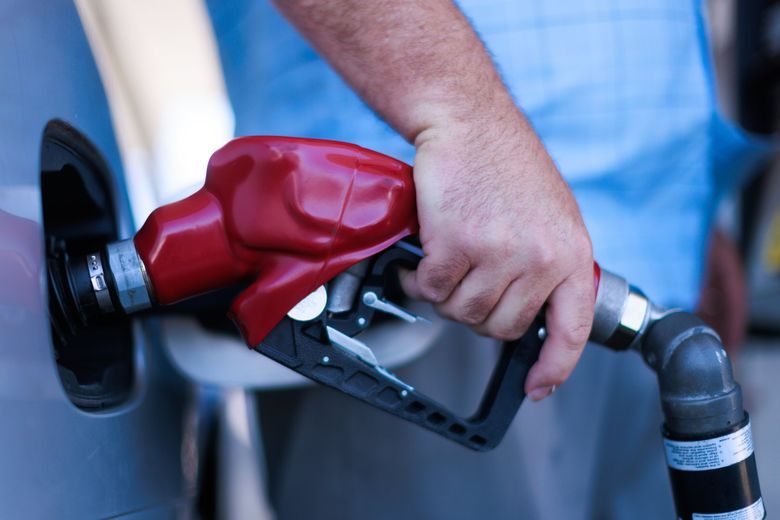
Here comes the money
Already a bit of cash is trickling out from the money raised at the auctions.
Next year state officials will launch a $5 million program offering rebates for electric bikes. And state Rep. April Connors, R-Kennewick, said she’ll introduce a bill next year to give registered vehicle owners up to $200 out of money raised from the auctions. Any cash raised above the $1.7 billion already budgeted should be refunded to taxpayers, she said.
Much of the money raised will go directly to those suffering the most from high gas prices, Doglio noted. Some 40% must go toward low-income homes and 10% must go to tribal nations.
But that money needs to be flying out the door now, Nguyen said.
“We can’t move at the speed of government and think that everything’s going to be OK,” he said.
Inslee promised more: “Real things in the next 12 months that are going to be visible for everyone,” he said.
Those things include free bus rides for kids, new electric school buses, an electric ferry, new charging stations, assistance for home insulation and rebates for heat pumps, he said.
The public’s perception of Washington’s carbon-pricing program and whether the policy faces — and survives — the repeal effort next November, will all have a ripple effect throughout the rest of the country.
Carlyle said he hopes the policy stands as a “light among nations,” an example to be followed.
Politicians in other states can marvel at the money Washington has raised so far, which will soon amount to billions of dollars.
“Do you know how jealous I am of that?” said Oregon state Rep. Pam Marsh.
Or they could look at the political turmoil and decide they don’t want the headache, Prakash said. Particularly if they don’t have a strong enough Democratic majority to push through major climate initiatives of their own. That’s likely a factor working against any possible attempt to create a federal carbon market, he said.
The Biden administration is not currently considering such a policy, U.S. Energy Secretary Jennifer Granholm said in an interview in August. Instead it is focused on creating climate-friendly initiatives with money from the federal Inflation Reduction Act.
Washington state’s successes and challenges can also influence whether other states are willing to join their markets with this one.
Oregon state Rep. Shelly Boshart Davis said in an email she wouldn’t want to expose her state to increased costs. While Oregon does have a carbon capping program state officials there and in Washington aren’t currently discussing joining their two programs.
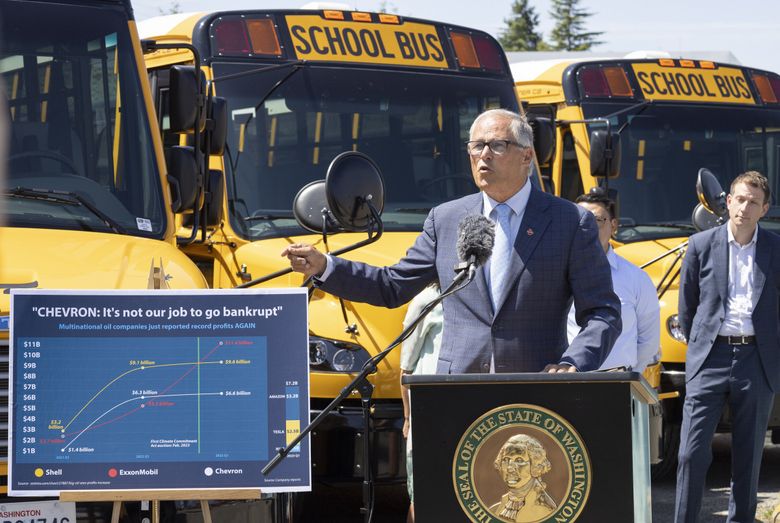
Washington could link its market with that of California and Quebec — which formed in 2014 — however. Representatives for the state and the Canadian province noted that the cost of gas, allowances and price containment mechanisms would be considered in such a move.
But so too would be the bigger picture, said Kim Ricard, director of Quebec’s Carbon Market Division. There is strength in numbers, and in the long run the move should lead to stability and the ultimate goal of reducing greenhouse gas emissions, Ricard said.
Cutting emissions is the goal, after all, Fitzgibbon said, and Washington’s carbon-pricing program will move the needle. If the current policies are painful, it’s because previous generations failed to act sooner, he said.
Fitzgibbon has leaned on an adage: The best time to plant a tree was decades ago. The second best time is right now.
Seattle Times staff reporter Isabella Breda contributed to this report.